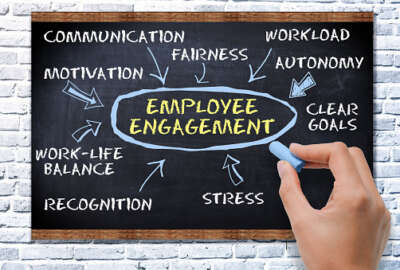

The Department of Veterans Affairs said its decision to consolidate the best of the Federal Employee Viewpoint Survey with its own assessment is paying off.
The Department of Veterans Affairs has long had a hunch that if its employees were engaged at work, its veteran customers would be satisfied too.
Now, the department said it has the tools to best measure employee engagement down to the lowest level — and target specific resources and expertise to help individual supervisors, managers and medical centers make improvements.
VA’s hypothesis was validated recently by the Partnership for Public Service and the Boston Consulting Group, which examined data from nearly 150 VA medical centers over three years. They found medical centers with stronger employee engagement had higher patient satisfaction, lower turnover among VA nurses and better call center performance.
The results aren’t so surprising to VA’s own National Center for Organization Development (NCOD), which acts as a consulting arm to the department’s health, benefits and cemetery administrations. The NCOD administers VA’s all-employee survey and conducts research on how employee engagement translates to better outcomes for the department’s customers.
“Every year the strongest correlation is always between employee engagement and customer satisfaction,” said Dee Ramsel, director of VA’s National Center for Organization Development, said in an interview with Federal News Network. “They can look at patient satisfaction data in VHA and it will match up with employee engagement scores at each facility. They can look at cemetery satisfaction scores and it will match up with employee engagement data.”
The Partnership highlighted two VA medical centers where this correlation has been particularly evident. Employee engagement at the VA St. Louis Health System rose nearly 3% between 2016 and 2018. Its Strategic Analytics for Improvement and Learning (SAIL) rating rose from two to four stars over the
VA’s medical center in Altoona, Pennsylvania, also saw similar boosts in engagement and patient satisfaction. Engagement at the Altoona medical center rose more than 16% over the past two years, according to the Partnership.
More detailed employee engagement metrics and a new, consolidated survey are also informing the way each medical center handles feedback from their workforce.
The St. Louis medical center, for example, used the survey results to develop a new supervisor academy for its curriculum. The medical center also began convening leadership development symposiums. The first meeting drew 60 people, but the next one attracted 150 employees, according to the Partnership.
VA began conducting its own all-employee survey 20 years ago. When the Office of Personnel Management began to administer its own, governmentwide Federal Employee Viewpoint Survey (FEVS), VA initially used both.
But VA last year decided to consolidate the two surveys and administer one. And the decision is paying off in multiple ways, Ramsel said.
First, VA is reaching a greater proportion of its workforce with one comprehensive survey.
The department reached about 9-to-10% of the VA workforce with the FEVS. But roughly 60% of the VA workforce took the department’s all-employee survey. Smaller participation rates are concerning for an organization of VA’s size, because engagement surveys tend to reach the most committed employees — and the most disgruntled ones, Ramsel said.
Second, the department can use its own survey to better map the results to more individual organizations and units — nearly 20,000 VA work groups in total, Ramsel said.
“Since the most important component of what determines employee engagement is the employee’s relationship with their supervisor, it’s really great that we can get these results down to the individual work group level,” she said. “The supervisor can work with their employees in their own individual work group and focus on the items that need improving in their work group. That’s the key to why we wanted to merge the best of the two surveys.”
VA’s 2018 survey included 30 of the 84 questions that OPM used in last year’s FEVS to measure employee satisfaction and engagement. But VA’s survey also includes questions that are unique to the department, Ramsel said.
“We’re very concerned about organization heath across VA,” she said. “We consider our survey somewhat of a screen. Employee engagement is certainty an incredibly important component of organization health, but we also ask questions about psychological safety, about safety and about burnout, for example.”
In addition, VA’s survey asks employees to evaluate how they believe their customers receive their own services. Ramsel said this question also generates a valuable perception of VA customer service, which is one of the department’s top priorities.
“Employees’ perception only, not actual hard data from veterans themselves, will correlate extremely highly with employee engagement scores,” she said. “Employees know when they’re engaged and they’re giving great customer service. They also know when their team isn’t functioning all that great and they’re not giving as great customer service.”
Once Ramsel’s team receives the survey results, the NCOD generates a variety of reports on the responses. Reports go to the secretary and each of VA’s administrations, as well as each medical center or regional office.
The reports “are a really important step for us, because we’re wanting 20,000 individual work groups to look at their individual data and use it for action planning,” Ramsel said. “If you’re not going to do anything with the data, you’d be better off not even administering the data, because employees get their hopes up. They think that they’re going to be listened to and something will be done to make their workplace better.”
VA’s National Center for Organization Development has also built an all-employee survey dashboard. All VA employees have access to it.
Members of the Senior Executive Service can get a high-level view of their organization’s results. Managers and supervisors each have their own view of the survey results, which are tailored to individual work groups.
The dashboard also includes tools and resources for supervisors and managers, which have helped medical center directors develop employee engagement action plans.
VA’s survey also asks employees to choose from 10 broad topics, such as communication and co-worker relationships, and rank the top three areas that they’d most like to see their own unit devote more attention to, Ramsel said.
“If you’re a supervisor you can look at the answer to that question, and you can go to your work group and start the dialogue right there,” she said. “It’s really that simple.”
Ramsel’s organization interviews medical center and regional directors where engagement has improved the most over the previous year. The NCOD also interviews the supervisors of work groups that have experienced the biggest improvements. Ramsel’s office will collect best practices and ideas from those interviews and disseminate them throughout the department.
VA’s employee engagement council has been working on a toolkit, which will highlight four broad areas the department believes are drivers of employee engagement. They include servant leadership, the employee’s voice, developing a innovative environment and employee training and recognition, Ramsel said.
“That toolkit will give actual examples of things that medical centers are already successfully doing to improve employee engagement,” she said.
NCOD research will inform a VA-wide employee engagement strategy, which the department’s councils are finalizing. The strategy will describe VA’s employee engagement plans for the next five years.
In addition, Ramsel’s office is organizing “supervisor week” to recognize and celebrate VA’s frontline managers.
“So often that position is [difficult],” she said. “You’re promoted because you’ve done a good job, but you don’t get enough training and you don’t get enough recognition. You have your employees squeezing you on one end and your manager squeezing on the other end.”
Copyright © 2024 Federal News Network. All rights reserved. This website is not intended for users located within the European Economic Area.
Nicole Ogrysko is a reporter for Federal News Network focusing on the federal workforce and federal pay and benefits.
Follow @nogryskoWFED


